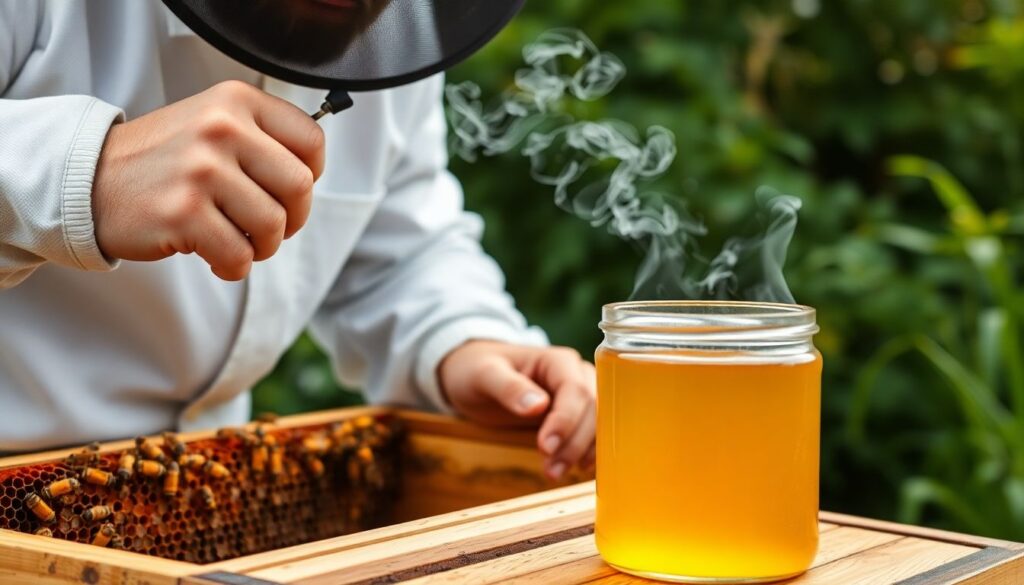Have you ever wondered what it would take to become a bee whisperer, tending to your own buzzing colony and reaping the sweet rewards of their labor? Welcome to the fascinating world of survival beekeeping, where the hum of bees is music to your ears, and the golden nectar they produce is more than just a delicious treat – it’s a vital resource for self-sufficiency and pollination. But let’s start with a question: Did you know that one in three bites of food you eat relies on pollinators, with honeybees being the most important?
Now, imagine being able to contribute to this critical ecosystem service while also producing your own honey, all from the comfort of your own backyard or homestead. Sounds like a dream? It’s not! With the right knowledge and a bit of elbow grease, you can become a beekeeper and make this dream a reality. That’s exactly what this article, ‘Survival Beekeeping: Honey Production and Pollination’, aims to help you achieve.
First, let’s agree on one thing: the importance of honeybees in our ecosystem and our lives cannot be overstated. They are the unsung heroes that keep our planet green and our tables laden with fresh produce. Now, let’s make a promise: by the end of this article, you will have a solid understanding of how to manage your own DIY beehives, harvest honey like a pro, and ensure your bees are thriving and pollinating like never before.
But before we dive into the nitty-gritty of bee management, let’s take a moment to appreciate the incredible journey of these tiny, striped warriors. Did you know that honeybees can fly up to 20 miles per hour, and in their lifetime, a single worker bee can produce about 1/12 of a teaspoon of honey? Now, consider this: to produce just one pound of honey, a colony of bees must visit around 2 million flowers and travel the equivalent of twice around the Earth! Isn’t that astonishing?
Now, let’s talk about the elephant in the room – or rather, the bear in the hive. Beekeeping can seem daunting, especially when you consider the potential for stings and the perceived complexity of managing a colony. But fear not! With the right techniques and a healthy dose of respect for these amazing insects, you’ll find that beekeeping is not only rewarding but also incredibly fun. And who knows, you might even find yourself with a newfound appreciation for the humble honeybee.
So, are you ready to roll up your sleeves, don your bee suit, and dive into the world of survival beekeeping? In this article, we’ll guide you through the process of setting up your first DIY beehive, providing you with tips on how to manage your colony, and teaching you the art of honey harvesting. We’ll also delve into the crucial role honeybees play in pollination and how you can ensure your colony is doing its part to keep our planet buzzing with life.
By the time you’ve finished reading, you’ll have the confidence and know-how to become a successful beekeeper, producing your own honey and contributing to the vital pollination process. So, let’s get started on this sweet adventure, and remember – every drop of honey is a testament to the incredible partnership between humans and these remarkable creatures.
Unveiling the Buzz: A Comprehensive Guide to DIY Beekeeping, Honey Harvesting, and Bee Management
Embark on a sweet adventure into the fascinating world of beekeeping with our comprehensive guide, ‘Unveiling the Buzz’. Dive into the art of DIY beekeeping, where you’ll learn to create a nurturing environment for your buzzing new friends. We’ll explore the fascinating lifecycle of bees, helping you understand their intricate social structure and communication methods. You’ll discover how to select the perfect hive, assemble it with care, and position it in your garden to attract and protect your colony. As your bees thrive, you’ll learn to manage their health, monitor their progress, and gently guide them towards a bountiful harvest. But the fun doesn’t stop at the hive! We’ll delve into the exciting process of honey harvesting, teaching you how to extract the golden nectar without disturbing the bees’ hard work. From uncapping frames to spinning out the honey, you’ll find step-by-step instructions and helpful tips to ensure a successful and rewarding harvest. So, are you ready to don your beekeeping suit and become a part of the buzz? Let’s dive in and unveil the secrets of this sweet and rewarding hobby together!

The Art of Beekeeping: A Brief History
The art of beekeeping, an ancient practice that has evolved over millennia, traces its origins back to the dawn of civilization. The earliest evidence of beekeeping dates back to around 9000 BC in Spain, where cave paintings depicting honey harvesting have been discovered. This suggests that our ancestors were aware of the value of honey and beeswax, and had begun to cultivate bees for these resources.
The ancient Egyptians, around 4500 BC, were among the first to document beekeeping practices. They kept bees in hollowed-out pots and used smoke to calm the bees, a technique still used today. The Egyptians revered bees and their honey, associating them with their sun god, Ra. This cultural significance is reflected in their art and hieroglyphics, which often depict bees and honeycombs.
In ancient Greece and Rome, beekeeping was also highly valued. The Greeks believed bees were born from the bodies of the dead, giving them a spiritual significance. They used honey in their medicine and as an offering to their gods. The Romans, meanwhile, were known for their innovative beehives, which were often made of clay or wood and had removable frames.
Fast forward to the Middle Ages, beekeeping in Europe was primarily a monastic pursuit. Monks kept bees for their honey and beeswax, which they used to make candles for their churches. They also traded these products, contributing to the growth of beekeeping as a commercial enterprise.
Modern beekeeping practices have been significantly shaped by these historical influences. The use of smoke to calm bees, for instance, is a technique that has been passed down through the centuries. The movable frame hive, invented in the 19th century, is a direct descendant of the Roman beehive. This design allows beekeepers to inspect their hives without destroying the comb, a practice that has greatly improved honey production and bee health.
Today, beekeeping is a global industry, with over 80 million hives worldwide. Yet, despite its modern scale, it remains deeply rooted in its ancient past. From the earliest cave paintings to the latest innovations in hive design, the art of beekeeping continues to evolve, carrying with it the cultural and historical significance that has shaped it over the millennia.
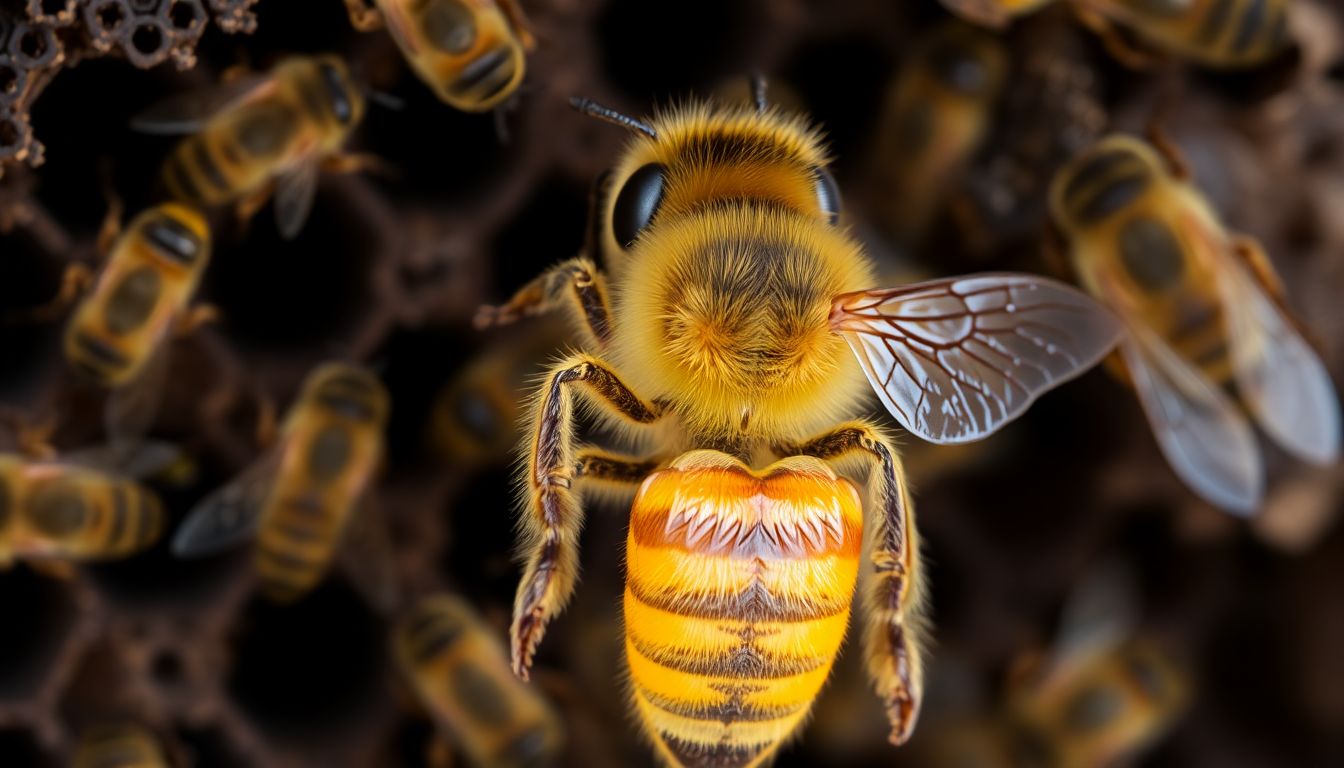
Understanding the Honeybee: Anatomy and Behavior
Diving into the captivating realm of honeybees, we find ourselves face to face with one of nature’s most remarkable creatures. These industrious insects, scientifically known as Apis mellifera, are not only exceptional pollinators but also masterful honey producers, a skill that has earned them a place of reverence in human culture since time immemorial.
The anatomy of a honeybee is a testament to its evolutionary success. A honeybee’s body is composed of three distinct parts: the head, thorax, and abdomen. The head houses the bee’s compound eyes, which provide a wide field of vision, and its antennae, which are used for sensing the environment. The thorax is the powerhouse of the bee, containing the muscles that drive its wings and enable it to fly at speeds of up to 25 miles per hour. The abdomen, meanwhile, is where the magic happens. It’s here that the bee’s sting is located, as well as its honey stomach, which is used to collect and store nectar.
But the honeybee’s most fascinating feature is arguably its social structure. Honeybees are eusocial insects, meaning they live in large, complex colonies that can number in the tens of thousands. Each colony is headed by a single queen, who is responsible for laying eggs and producing pheromones that regulate the behavior of the other bees in the colony. The rest of the bees in the colony are workers, who are all female and perform a variety of tasks, including foraging for food, caring for the young, and defending the hive. The males, known as drones, have a single purpose: to mate with new queens.
One of the most enduring myths about honeybees is that they die after they sting. While it’s true that worker bees have barbed stingers that can become lodged in their victim’s skin and ultimately cause their death, this is not the case for all bees. Queen bees, for example, have smooth stingers that allow them to sting multiple times without dying. Additionally, drones do not have stingers at all.
Another fascinating aspect of honeybee behavior is their ability to communicate with one another through a complex system of dances. When a forager bee discovers a patch of flowers, it returns to the hive and performs a ‘waggle dance’ to communicate the location of the food source to its fellow bees. The angle of the dance relative to the sun indicates the direction of the food, while the duration of the waggling run indicates its distance. This remarkable form of communication allows the colony to quickly and efficiently exploit new food sources, ensuring the survival and prosperity of the entire group.
In conclusion, the honeybee is a truly extraordinary creature, with a unique anatomy and complex social structure that have evolved over millions of years to enable it to thrive in a wide range of environments. By understanding the honeybee, we can gain valuable insights into the workings of the natural world and appreciate the vital role that these humble insects play in our own lives.
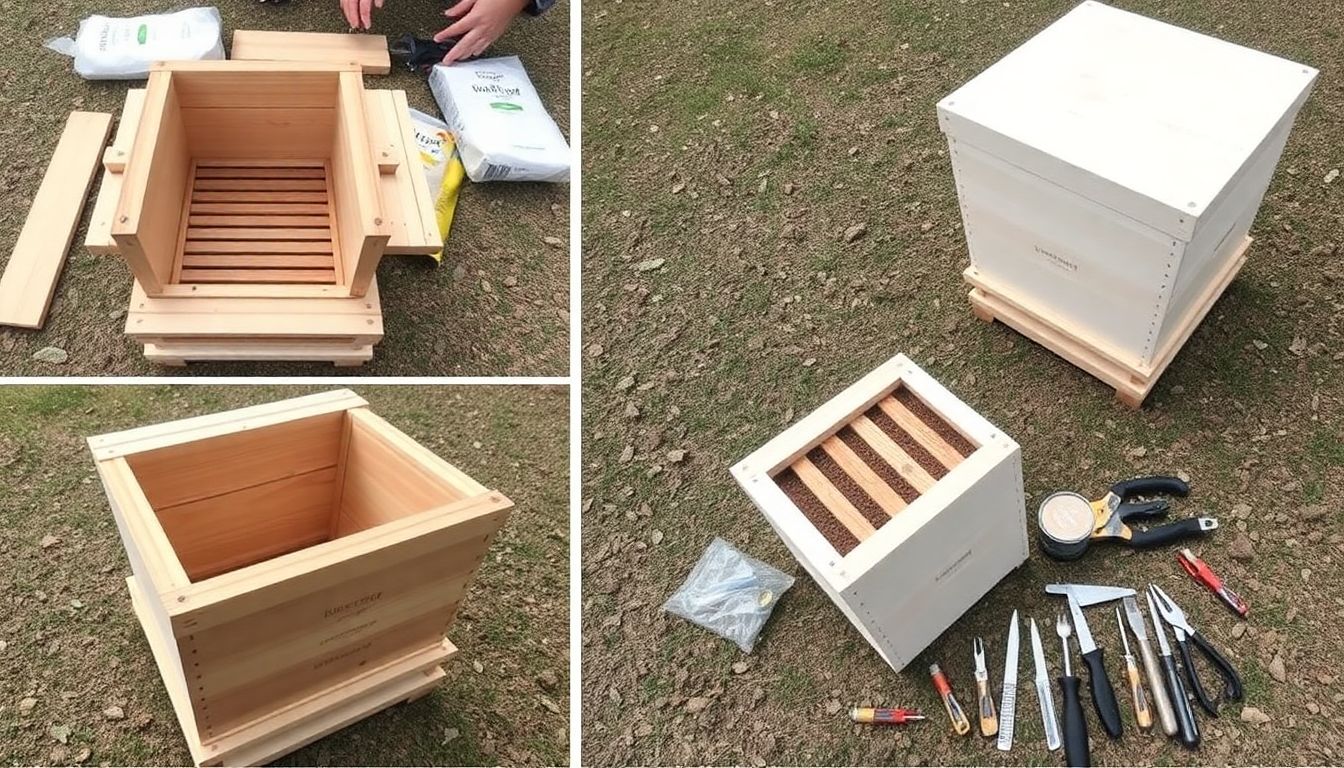
Setting Up Your First DIY Beehive
Embarking on the fascinating journey of beekeeping starts with setting up your first beehive. This involves a decision between building or purchasing your hive, and choosing from various types, each with its unique advantages and drawbacks. Let’s delve into the world of beekeeping, step by step. The Langstroth hive, named after its inventor L.L. Langstroth, is the most common type worldwide. It’s a vertical hive with a series of rectangular boxes, or ‘supers’, stacked on top of each other. The Langstroth hive offers easy inspection and harvesting of honey, and it’s highly adaptable, allowing beekeepers to add or remove boxes as needed. However, it requires more frequent inspections due to its design, which can disturb the bees.
For those seeking a more natural approach, the Top Bar hive and the Warre hive are excellent alternatives. The Top Bar hive, popularized by the late Phil Chandler, consists of a long, shallow box with bars across the top where the bees build their comb. It’s simple to build, easy on the bees, and allows for gentle, non-intrusive inspections. However, it may not be suitable for areas with high bee populations, as it doesn’t allow for expansion like the Langstroth hive. The Warre hive, designed by Abbé Émile Warré, is a vertical hive with a series of shallow, curved boxes. It’s designed to mimic the natural behavior of bees in a hollow tree, promoting a strong, self-regulating colony. It’s gentle on the bees and requires less frequent inspections, but it may not be suitable for all climates and can be more challenging to harvest honey from.
Regardless of your chosen hive type, there are essential pieces of equipment you’ll need to get started. A bee suit and gloves are crucial for protecting both you and the bees during inspections. A smoker is used to calm the bees by disrupting their communication and causing them to consume honey, making them less likely to sting. A hive tool is necessary for prying apart the hive boxes and removing frames. And, of course, you’ll need your chosen hive, complete with frames for the bees to build their comb on.
Building your own hive can be a rewarding experience, allowing you to customize it to your specific needs and preferences. However, purchasing a pre-made hive ensures a sturdy, well-constructed home for your bees. Whichever route you choose, remember that patience and gentle handling are key when working with bees. They’re not just producing honey; they’re building a home, and they deserve our respect and care.
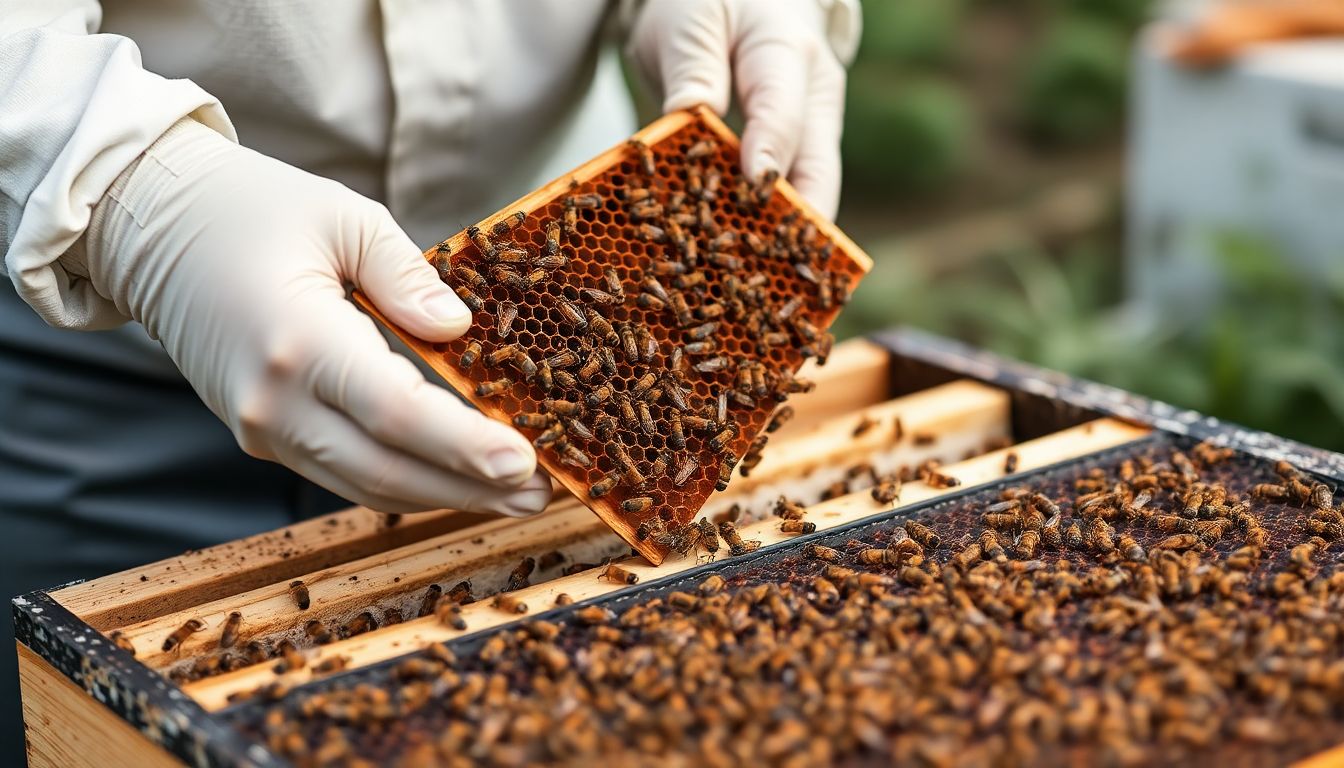
Attracting and Installing Your First Bee Colony
Attracting and installing your first bee colony is an exciting step towards becoming a beekeeper. Let’s explore both methods: attracting wild swarms and purchasing a nucleus colony, followed by a detailed guide on installing bees into their new home.
To attract wild swarms, create an appealing environment for bees. Plant bee-friendly flowers like lavender, sunflowers, and clover. Place your hive in a sunny spot, facing southeast, and ensure it’s at least 20 feet away from your home. Swarms are looking for a new home, so make your hive irresistible. You can also purchase a swarm lure, which mimics the pheromones of a queen bee, to increase your chances.
Alternatively, you can purchase a nucleus colony, also known as a ‘nuc’. These are small colonies with a laying queen, workers, and a small amount of brood. They’re perfect for beginners as they’re easier to manage and less likely to swarm. You can buy them from local beekeepers, beekeeping supply stores, or online.
Once you have your colony, it’s time to install them into their new home. Here’s a step-by-step guide:
- First, ensure your hive is assembled and painted with a light color to reflect heat. Place it in your chosen location.
- If you’re installing a nuc, gently remove the lid and inner cover. You’ll see a cluster of bees around the queen. Gently brush them aside.
- Carefully lift the nuc box and place it into the bottom box of your hive. Make sure the entrance is facing the right direction.
- Replace the inner cover and lid, ensuring they’re secure.
- If you’re installing a swarm, gently shake the cluster of bees into the hive, ensuring the queen is among them.
- Leave the hive undisturbed for a few days to allow the bees to draw out the wax and start building comb.
By following these steps, you’ll ensure a smooth transition for your new bee colony. Happy beekeeping!

Nurturing Your Bee Colony: Essential Bee Management Techniques
Nurturing a thriving bee colony is a rewarding journey that requires diligent care and attention. Regular hive inspections are the cornerstone of bee management, enabling you to monitor the colony’s health and productivity. By conducting weekly inspections during the active season, you can keep a close eye on the queen’s productivity, the brood pattern, and the honey stores. This regular interaction also helps you identify and address any potential issues early on.
Preventing and treating common hive pests and diseases is another crucial aspect of bee management. Varroa mites, wax moths, and American foulbrood are among the most prevalent threats to your colony. To mitigate these, maintain good hygiene by regularly replacing old combs, ensuring proper ventilation, and using organic or chemical-free treatments when necessary. Additionally, consider using screened bottom boards and installing mite traps to monitor and control mite populations.
Managing swarms is an exciting and inevitable part of beekeeping. Swarming is a natural process by which a colony reproduces, but it can also lead to a loss of bees if not managed properly. To prevent swarming, ensure your colony has enough space by adding supers or dividing the colony. If a swarm does occur, remain calm and follow these steps: locate the swarm, carefully collect it using a net or a swarm trap, and transfer it to a new hive.
Lastly, ensuring the colony’s overall health and productivity is the ultimate goal of bee management. This involves providing a balanced diet of pollen and nectar, ensuring a consistent water source, and protecting the colony from extreme weather conditions. By maintaining a healthy colony, you’ll be rewarded with an abundance of honey and a thriving ecosystem that contributes to pollination and biodiversity.
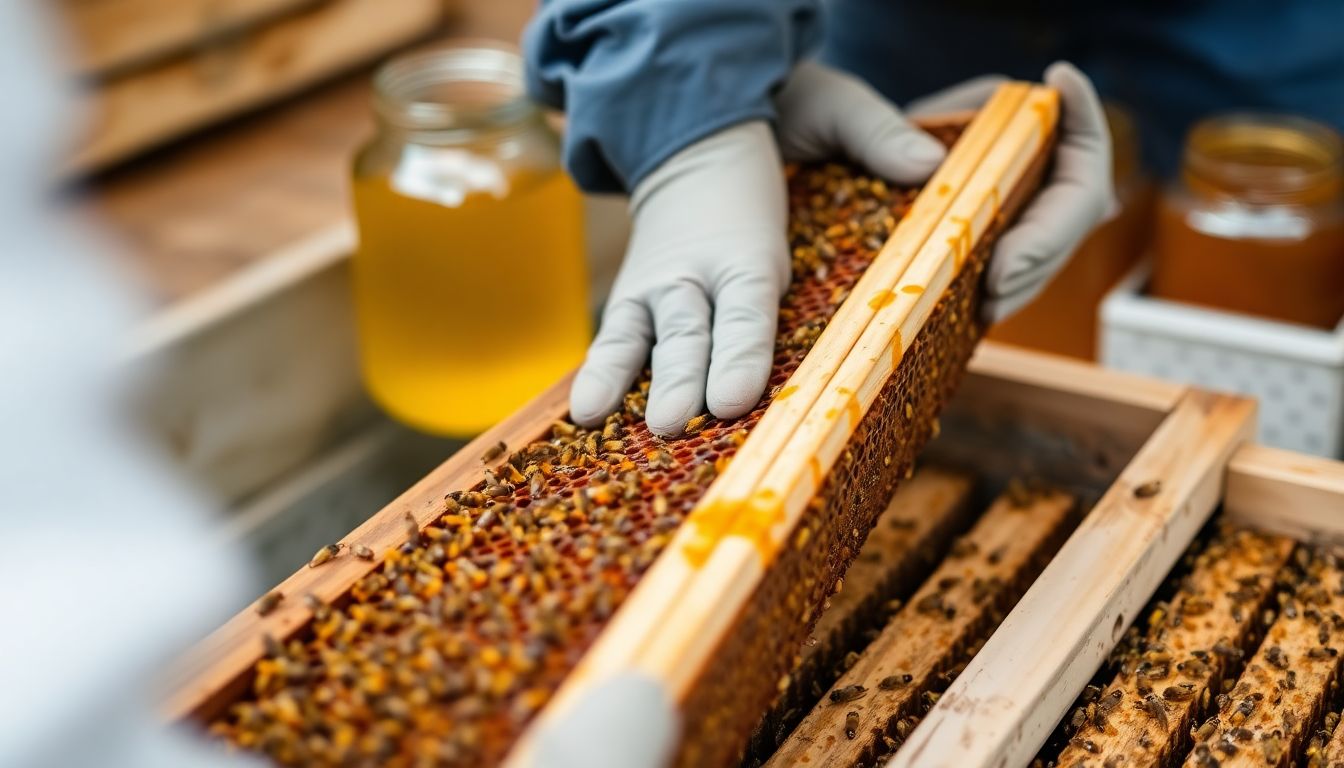
The Sweet Reward: Maximizing Honey Production
In the enchanting dance of beekeeping, the sweet reward is not just the golden honey that fills our jars, but also the harmonious balance we maintain with our buzzing friends. To maximize honey production, we must become adept at nurturing this symbiotic relationship. Let’s delve into some strategies that can help us achieve this. First and foremost, providing optimal nutrition is key. Bees require a diverse range of plants to ensure they gather a broad spectrum of nutrients. Planting a variety of flowers, both native and cultivated, can provide a steady supply of nectar and pollen throughout the growing season. This not only increases the chances of a bountiful harvest but also supports the overall health of the colony. Managing supers effectively is another crucial aspect. Supers are the boxes that sit atop the hive and are used to store excess honey. By understanding the role of nectar flow, we can time the addition of these supers perfectly. Nectar flow refers to the period when flowers are in full bloom and producing ample nectar. Adding supers during this time allows the bees to store more honey, thereby increasing the yield. However, it’s essential to strike a balance. Bees need to store enough honey to survive the winter, so it’s important not to take all the honey from the hive.
Understanding the bees’ needs and respecting their natural instincts is vital. Bees are incredibly efficient and will only produce as much honey as they need for survival and reproduction. Therefore, it’s our responsibility to ensure they have enough food stores to see them through the leaner months. A general rule of thumb is to leave at least 40-60 pounds of honey in the hive for the bees’ winter consumption. Additionally, regular inspections of the hive can help us identify any potential issues early. This could be anything from a weak queen to a lack of space in the hive. Addressing these issues promptly can help maintain the health and productivity of the colony. In conclusion, maximizing honey production is not just about maximizing yield, but also about maintaining a healthy and sustainable apiary. By providing optimal nutrition, managing supers effectively, understanding nectar flow, and respecting the bees’ needs, we can enjoy a sweet reward while ensuring the survival and well-being of our buzzing friends.
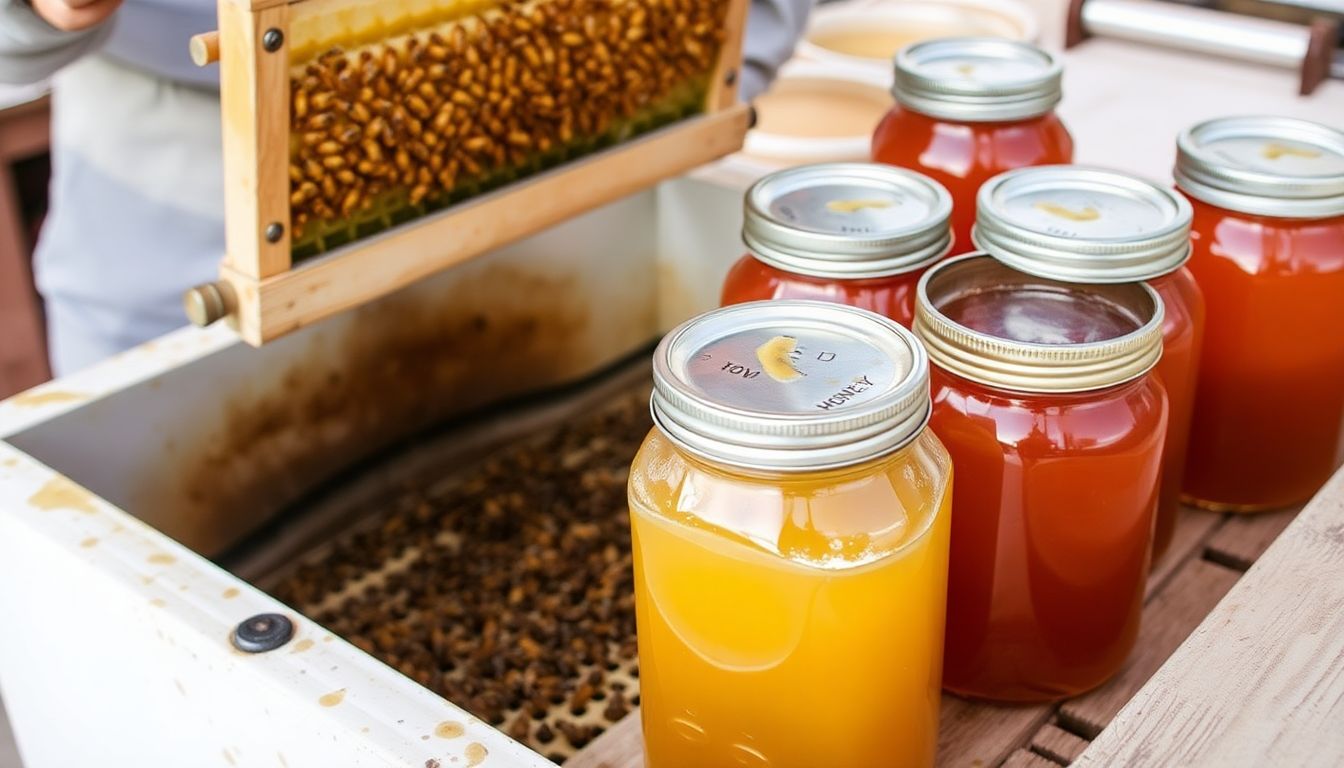
Harvesting Honey: The Art and Science
Harvesting honey is an age-old process that combines the art of beekeeping with the science of apiology. The journey begins with the patient and careful uncapping of the sealed honeycomb frames, a task that requires a steady hand and a gentle touch to avoid damaging the delicate wax structures. This initial step is crucial, as it allows the honey to flow freely during the extraction process.
The uncapped frames are then placed in a centrifugal honey extractor, a machine that spins the honey out of the comb using centrifugal force. This is where the science comes into play, as the force generated by the extractor must be just right to remove the honey without crushing the comb or damaging the beeswax.
Once the honey has been spun out, it’s time to filter the liquid gold. A fine mesh strainer is used to remove any wax particles or pollen that may have made their way into the honey. This step is essential for ensuring a pure, high-quality product.
The filtered honey is then ready for bottling. Care must be taken to fill the jars to the correct level, leaving enough space for the honey to expand as it crystallizes over time. A small piece of wax or a circle of parchment paper is often placed on top of the honey to keep any foreign particles out.
To ensure the honey remains pure and unpasteurized, it’s important to keep it at a cool temperature during the bottling process. This helps to preserve the natural enzymes and antioxidants that give honey its many health benefits.
Finally, the bottled honey is labeled and stored in a cool, dark place until it’s ready to be enjoyed. The entire process, from uncapping the frames to bottling the honey, is a labor of love that requires patience, skill, and a deep respect for the bees and their honey.

Beyond Honey: The Importance of Pollination
Beyond the sweet nectar they produce, honeybees play an indispensable role in our ecosystem and agriculture, primarily through their pollination services. Pollination, the process by which pollen is transferred from the male part of a flower to the female part, enabling fertilization and reproduction, is a critical step in the life cycle of plants. Honeybees, with their hairy bodies and specialized pollen baskets, are nature’s most efficient pollinators. They collect nectar and pollen from flowers, inadvertently transferring pollen between plants as they forage.
This service is not only crucial for wild plants but also vital for global agriculture. According to the United Nations, around 75% of the world’s flowering plants and about 35% of the world’s food crops depend on animal pollinators to reproduce. From fruits and vegetables to nuts and seeds, the diversity and abundance of our food rely heavily on these tiny, winged workers.
Beekeepers, guardians of these industrious insects, can support and enhance these pollination services in several ways. Firstly, they can provide optimal habitats for their bees, ensuring they have access to diverse, healthy forage. This can be achieved by planting bee-friendly flowers and avoiding the use of harmful pesticides. Secondly, beekeepers can strategically place their hives to maximize pollination. For instance, they can position hives near orchards or fields of crops that rely on pollinators, such as almonds or apples. Lastly, beekeepers can also engage in ‘managed pollination’, where they transport hives to specific locations to ensure adequate pollination. By doing so, they not only support the health of their own colonies but also contribute to the productivity of farms and the preservation of wild plant species.
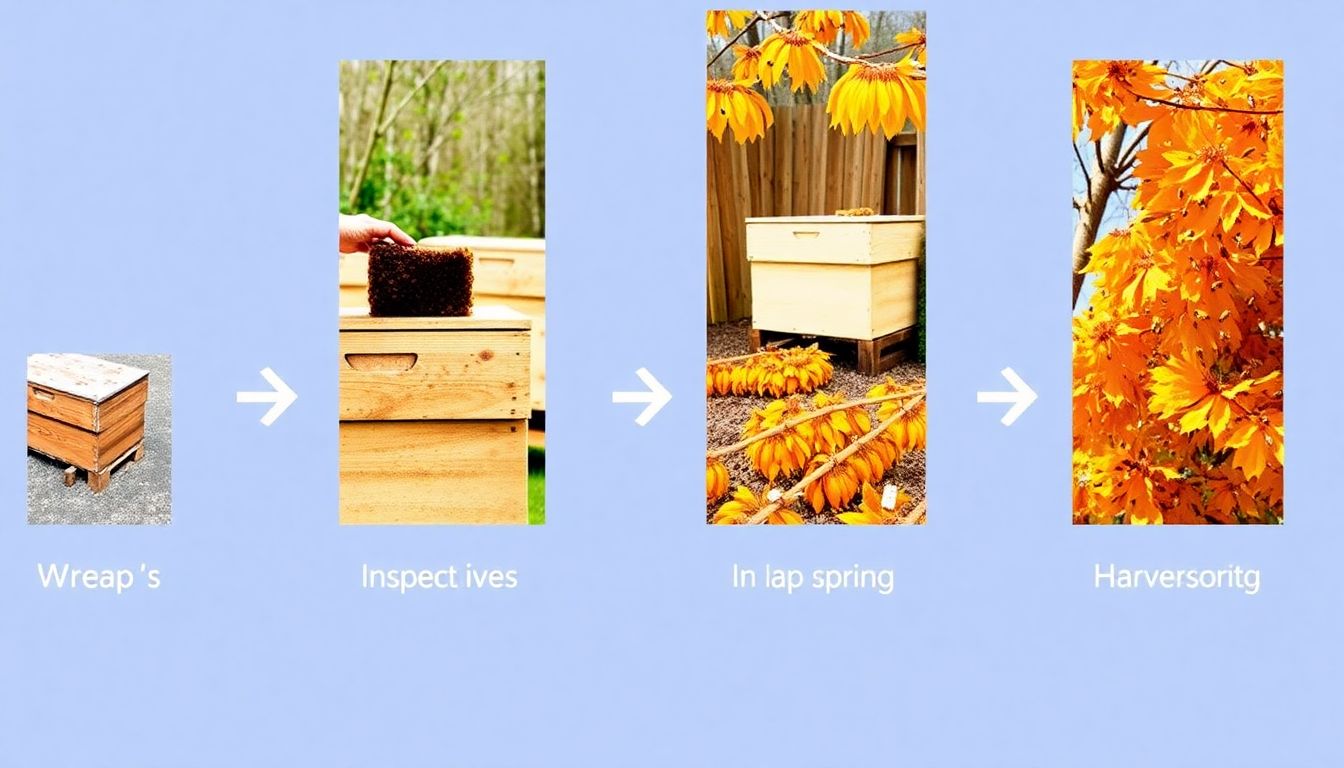
The Beekeeper’s Calendar: Seasonal Tasks and Management
The art of beekeeping is a dance with the seasons, each one bringing unique tasks and considerations to ensure the health and productivity of your apiary. Let’s embark on this seasonal journey, from the quiet hush of winter to the bustling hum of fall.
Winter: The Season of Preparation and Patience Winter, the longest season for beekeepers, is a time of quiet anticipation. The bees cluster together, shivering in unison to keep warm, consuming the honey they’ve stored for this very purpose. Your task? Patience, and preparation for the coming seasons. Ensure your hives are well-ventilated to prevent moisture buildup, and consider wrapping them for added insulation. Check on your bees periodically, but remember, too many disturbances can deplete their energy reserves.
Spring: Awakening and Buildup Spring arrives with a buzz, as bees emerge from their winter slumber. It’s time to inspect your hives, replacing any damaged frames, and ensuring there’s enough space for the growing colony. Feed your bees if necessary, to help them build up their strength and numbers. This is also the season for swarm control, as colonies may split to start anew elsewhere. Keep an eye out for queen cells, and consider splitting your hives to prevent swarming.
Summer: The Height of Productivity Summer is the beekeeper’s reward, as hives hum with activity, producing honey in abundance. Monitor your hives regularly to ensure they have enough space, and consider adding supers to harvest the surplus honey. This is also the season for varroa mite management, as the warm weather favors their reproduction. Use organic methods like essential oils or powdered sugar dusting to control mites, and consider splitting your hives to increase productivity.
Fall: Harvest and Preparation Fall is harvest time, as bees bring in the last of the season’s nectar. It’s time to remove the honey supers, leaving enough for the bees to survive the winter. Replenish their stores with sugar syrup if necessary, and prepare your hives for the coming cold. Inspect your equipment, repairing or replacing as needed, and store it in a dry place to prevent mold and mildew. And so, the cycle begins anew, as the beekeeper’s calendar turns another page.
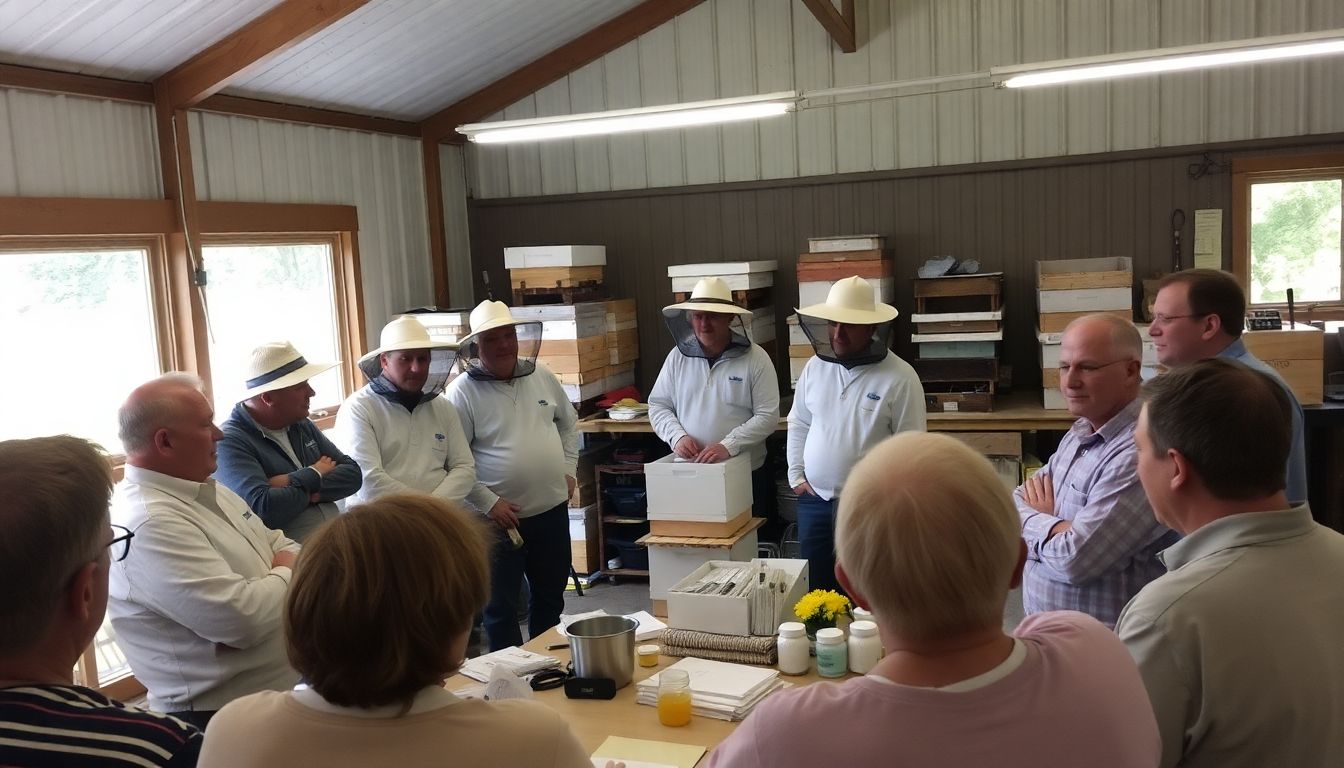
The Beekeeping Community: Resources and Support
Embarking on the fascinating journey of beekeeping often feels like stepping into a secret, buzzing world. While bees may be the stars of the show, it’s the beekeeping community that provides the wings for this endeavor to truly take flight. Connecting with fellow beekeepers, both locally and online, is not just a nice addition to your apiary adventure, but a crucial one.
The importance of this connection cannot be overstated. Beekeeping, much like gardening, is a craft that benefits from shared knowledge and experience. Seasoned beekeepers can offer invaluable advice on everything from hive management to honey harvesting. They can also provide a sounding board for your questions and concerns, helping you navigate the challenges that inevitably arise.
But where does one find this community? The answer is as varied as the bees themselves. Locally, beekeeping clubs and associations are a fantastic starting point. These groups often host meetings, workshops, and even field days, providing hands-on learning opportunities. They also serve as a hub for local beekeepers to share news, resources, and support.
For those who prefer the digital hive, the online beekeeping community is thriving. Websites like BeeSource and Beekeeping.com offer forums where beekeepers from around the world can connect, ask questions, and share their experiences. Social media platforms, particularly Facebook, are home to numerous beekeeping groups where real-time advice and camaraderie can be found.
Books, too, play a significant role in the beekeeping community. They provide a wealth of information, from the basics of bee biology to advanced techniques. Some popular choices include ‘The Beekeeper’s Handbook’ by Diana Sammataro and Alphonse Avitabile, and ‘Beekeeping for Beginners’ by Richard E. Bonney. These texts offer a solid foundation of knowledge, while also encouraging further exploration.
In conclusion, the beekeeping community is a vibrant, supportive network that extends far beyond the confines of your backyard apiary. Whether you’re a seasoned beekeeper or just starting out, connecting with this community can greatly enrich your beekeeping experience. So, don your bee suit, grab your smoker, and join the buzz
- the beekeeping community is waiting to welcome you.
FAQ
What are the basic components of a DIY beehive?
How do I ensure my bees have a good start in their new hive?
What is the best time of year to harvest honey?
How do I know when my bees have produced enough honey for a harvest?
What equipment do I need for honey harvesting?
How do I extract honey from the comb without damaging it?
- First, remove the honey supers from the hive and place them in your bee suit to keep the bees calm.
- Use a uncapping fork or knife to remove the wax cappings from the honeycomb.
- Place the frames in the extractor, making sure they are balanced and secure.
- Spin the extractor at a moderate speed, typically around 900-1200 RPM, until the honey is fully extracted.
- Remove the frames from the extractor and scrape any remaining honey from the comb using a honey scraper.
- Filter the extracted honey through a strainer to remove any wax particles or debris.
How can I ensure my bees have enough food to survive the winter?
- Leave enough honey in the hive for the bees to survive the winter. A good rule of thumb is to leave at least 40-60 pounds of honey in the hive.
- Feed your bees a sugar syrup or pollen patties in the fall to help them build up their stores for the winter.
- Provide your bees with a source of pollen, such as pollen patties or a pollen substitute, to help them build up their strength and produce more honey.
- Insulate your hive to help keep the bees warm during the winter. You can use straw, foam board, or even a quilt box to insulate the hive.
How do I manage my bees to maximize honey production?
- Provide your bees with a strong foundation by starting with a healthy colony and giving them a good location with plenty of nectar sources.
- Monitor your colony regularly to ensure it’s healthy and productive. Look for signs of disease, pests, or a weak queen, and take action as needed.
- Add honey supers to your hive as the colony grows and the bees start to produce excess honey. Make sure to use a queen excluder to prevent the queen from laying eggs in the honey supers.
- Split your colony in the spring to create new colonies and increase your honey production. This can be done by dividing the hive and giving each new colony a laying queen or by using a nucleus colony (nuc) to start a new colony.
- Feed your bees a sugar syrup or pollen patties during periods of low nectar flow to help them build up their stores and produce more honey.



